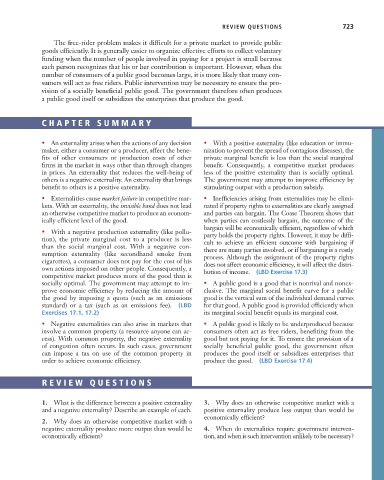Page 749 - Microeconomics, Fourth Edition
P. 749
c17ExternalitiesandPublicGoods.qxd 8/22/10 4:56 AM Page 723
REVIEW QUESTIONS 723
The free-rider problem makes it difficult for a private market to provide public
goods efficiently. It is generally easier to organize effective efforts to collect voluntary
funding when the number of people involved in paying for a project is small because
each person recognizes that his or her contribution is important. However, when the
number of consumers of a public good becomes large, it is more likely that many con-
sumers will act as free riders. Public intervention may be necessary to ensure the pro-
vision of a socially beneficial public good. The government therefore often produces
a public good itself or subsidizes the enterprises that produce the good.
CHAPTER SUMMAR Y
• An externality arises when the actions of any decision • With a positive externality (like education or immu-
maker, either a consumer or a producer, affect the bene- nization to prevent the spread of contagious diseases), the
fits of other consumers or production costs of other private marginal benefit is less than the social marginal
firms in the market in ways other than through changes benefit. Consequently, a competitive market produces
in prices. An externality that reduces the well-being of less of the positive externality than is socially optimal.
others is a negative externality. An externality that brings The government may attempt to improve efficiency by
benefit to others is a positive externality. stimulating output with a production subsidy.
• Externalities cause market failure in competitive mar- • Inefficiencies arising from externalities may be elimi-
kets. With an externality, the invisible hand does not lead nated if property rights to externalities are clearly assigned
an otherwise competitive market to produce an econom- and parties can bargain. The Coase Theorem shows that
ically efficient level of the good. when parties can costlessly bargain, the outcome of the
bargain will be economically efficient, regardless of which
• With a negative production externality (like pollu- party holds the property rights. However, it may be diffi-
tion), the private marginal cost to a producer is less cult to achieve an efficient outcome with bargaining if
than the social marginal cost. With a negative con- there are many parties involved, or if bargaining is a costly
sumption externality (like secondhand smoke from process. Although the assignment of the property rights
cigarettes), a consumer does not pay for the cost of his does not affect economic efficiency, it will affect the distri-
own actions imposed on other people. Consequently, a bution of income. (LBD Exercise 17.3)
competitive market produces more of the good than is
socially optimal. The government may attempt to im- • A public good is a good that is nonrival and nonex-
prove economic efficiency by reducing the amount of clusive. The marginal social benefit curve for a public
the good by imposing a quota (such as an emissions good is the vertical sum of the individual demand curves
standard) or a tax (such as an emissions fee). (LBD for that good. A public good is provided efficiently when
Exercises 17.1, 17.2) its marginal social benefit equals its marginal cost.
• Negative externalities can also arise in markets that • A public good is likely to be underproduced because
involve a common property (a resource anyone can ac- consumers often act as free riders, benefiting from the
cess). With common property, the negative externality good but not paying for it. To ensure the provision of a
of congestion often occurs. In such cases, government socially beneficial public good, the government often
can impose a tax on use of the common property in produces the good itself or subsidizes enterprises that
order to achieve economic efficiency. produce the good. (LBD Exercise 17.4)
REVIEW QUESTIONS
1. What is the difference between a positive externality 3. Why does an otherwise competitive market with a
and a negative externality? Describe an example of each. positive externality produce less output than would be
economically efficient?
2. Why does an otherwise competitive market with a
negative externality produce more output than would be 4. When do externalities require government interven-
economically efficient? tion, and when is such intervention unlikely to be necessary?

